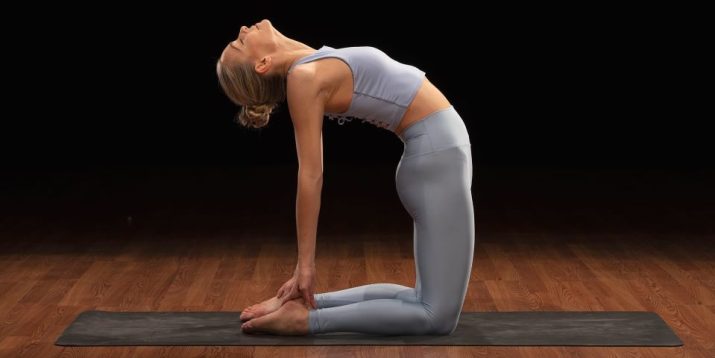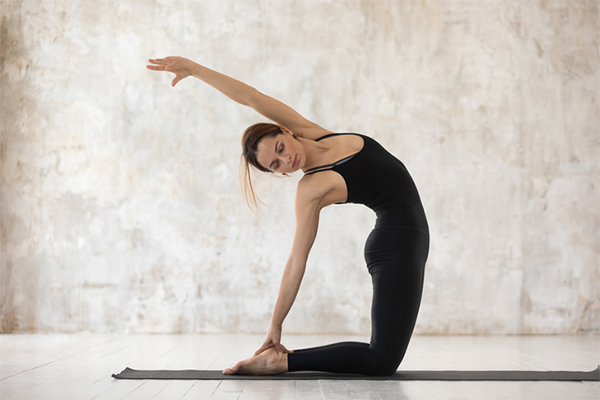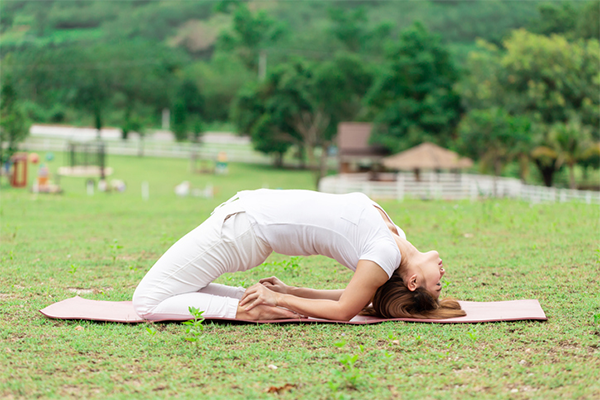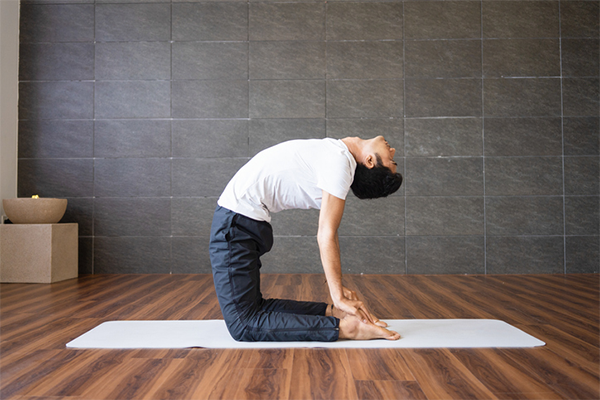How to Do Camel Pose in Yoga (Ustrasana)

Camel pose (ustrasana, as it’s known in Sanskrit) seems simple: You kneel down, arch your back, and grab your heels. But this backbend and chest opener has so much more going on.
Camel pose is accessible to yogis of all levels (barring any lower-back or neck issues), and ustrasana‘s (ustra = camel, and asana = posture or seat) benefits far outweigh the effort required to master it.
When performed correctly and safely, the pose takes the shape of a camel’s hump.
In the second series of ashtanga yoga, camel pose is the first of three kneeling backbends that increase in difficulty. Iyengar yoga uses props to make ustrasana more accessible.
Whether you’re new to yoga or a seasoned practitioner, you’ll want to warm up before attempting this backbend.
Consider starting with a hip flexor stretch (like pigeon pose or one of these poses for the hips), and some chest stretches like bow pose, as well as backbends like upward-facing dog or cobra pose.
Camel Pose (Ustrasana): Step-by-Step Instructions
Here’s how to safely assume camel pose, provided you don’t need to modify it.
- Start in a kneeling position, with your knees directly under your hips and the tops of your feet flat against the mat.
- With your chest lifted and core engaged, slightly contract your glutes, push your hips and thighs forward, and reach for your heels.
- Look up to lengthen your neck, and drop your head back if you can. (If not, just look toward the ceiling; holding your head halfway back can strain your neck.)
- Hold for at least five breaths, up to one minute.
- To return to the starting position, engage your core, and push into your feet and shins to slowly bring yourself forward. Your head should come up last.
How to Make Camel Pose Easier

Camel pose shouldn’t be rushed. If you can’t comfortably reach your heels, or if you feel like you can’t breathe, try one of these modifications to make ustrasana easier.
- Can’t reach your heels comfortably? 1. Tuck your toes, 2. Reach for one heel at a time, and/or 3. Use blocks on either side of your feet.
- A nice warm-up or beginner’s version of camel pose leaves out the heels entirely. Instead, place your hands on your lower back, fingertips pointing down.
- Camel pose extends your abdominal wall, which can make breathing harder, says Stephanie Saunders, BODi vice president of fitness programming and a certified yoga instructor. “Perhaps this is because we think of our lungs as being in front of our bodies, as opposed to being surrounded by our ribcage,” says Saunders. “Think about expanding and breathing in the back side of your body, which will allow more freedom in camel.”
How to Make Camel Pose Harder

Ustrasana is a gateway posture to other kneeling backbends. Once you feel comfortable in the basic pose, use these suggestions to make camel pose harder.
- If you’re struggling to stay upright in camel pose and notice your thighs are angling back (instead of over your knees), go to the wall. Kneel in front of the wall, come into camel pose, and push your hip bones firmly into the wall. This will build major strength and muscle memory to help you safely progress in the pose. By pushing your hips into the wall, you help ensure you’re bending from the thoracic spine versus the lumbar, which can strain your back.
- Take camel pose into little thunderbolt pose (laghu vajrasana): Keep your hips pushing forward, but walk your hands onto the backs of your calves. Keep your arms straight, and let your head drop down to the floor. As with camel, don’t relax; your head should bear little to no weight.
- To test the strength of your quads and adductors, take your hands off your heels (you can place them on your lower back) while you stay in your deepest camel pose.
Bonus/Beginner’s Tips for Doing Camel Pose
Camel pose can be complicated, and there’s much to be learned from it. Here are some tips for progressing in ustrasana.
- Contract your glutes to lengthen your spine (but don’t squeeze/clench, which will crunch your low back), and keep your abs engaged.
- Use a block between your knees to keep them hip-width apart, and to encourage internal rotation of your thighs (squeeze the block to fire up your adductors and quads).
- Focus on your neck. “Finding a healthy extension of the cervical spine can be difficult in ustrasana,” says Saunders. “Focusing on lengthening from the anterior part of the neck — and not contracting the muscles on the side of the neck (sternocleidomastoid) — will keep your skull from crunching into your vertebrae.”
- Avoid squeezing your shoulder blades together or sinking into your hands/wrists. Instead, think about opening your chest (keeping your collarbones wide) and keeping your weight forward in your hips/thighs (not in your hands).
- Don’t “give up” — this isn’t a pose in which you can relax once you reach your peak.
Benefits of Camel Pose

Above all, camel pose is a back bend and chest opener. Here are some of its other benefits.
Stretches the front body
Camel pose stretches the psoas, as well as the whole front of your body. You’ll feel a nice stretch in your other hip flexors, quads, neck, and chest.
Improves posture
The hunched-over carriage associated with most office work can lead to shortened hip flexors and forward stress on the spine. Camel pose can help counteract the effects of sitting all day.
Increases spinal flexibility
As a back bend, camel pose will help make your spine more limber, especially the thoracic spine.
Take your practice further with BODi’s Yoga52, a collection of 52 elegantly-produced yoga classes from beginner to expert taught by five of the world’s leading yoga instructors.
